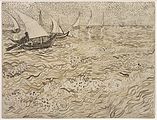|
Saintes-Maries (Van Gogh series)
 The French town of Saintes-Maries-de-la-Mer is the subject of a series of paintings that Vincent van Gogh made in June 1888. When Van Gogh lived in Arles, he took a week-long trip to Saintes-Maries-de-la-Mer on the Mediterranean Sea, where he made several paintings of the seascape and town. The work he produced in Saintes-Maries took on a more experimental and expressive style than his earlier work.[1] Over the course of his visit, Van Gogh made two paintings of the sea, one of the village, and nine drawings.[2] Saintes-Maries-de-la-MerAt the time of Van Gogh's visit, Saintes-Maries was a small fishing village with 800 residents. Van Gogh likely stayed at the Pension Coulomb, a short walk from the beach.[3] Van Gogh intended to use his trip to recover from health problems and make some seaside paintings and drawings.[4] The painter described the town in a letter to his brother Theo. He wrote, "The beach here is sandy, no cliffs or rocks—like Holland—without the dunes and with more blue." In the same letter, he commented on the town's good seafood as well as the town's demographics and geography, writing, "I don’t believe there are 100 houses in this village or town. The main building after the old church, an ancient fortress, is the barracks."[5] Paintings of the seaFishing Boats on the Beach at Saintes-Maries-de-la-MerOne painting Van Gogh worked on while in the village was Fishing Boats on the Beach at Saintes-Maries-de-la-Mer (F413). He described the painting in a letter to Theo: "I made the drawing of the boats when I left very early in the morning, and I am now working on a painting based on it, a size 30 canvas with more sea and sky on the right. It was before the boats hastened out; I had watched them every morning, but as they leave very early I didn't have time to paint them."[6] Some of the work on the painting was finished in the studio, such as capturing the light in the sand, sea and sky.[4] The Sea at Les Saintes-Maries-de-la-Mer The Sea at Les Saintes-Maries-de-la-Mer (F415) depicts three boats floating on a calm sea with special attention to light and color. A fisherman is visible guiding the boat in the painting’s foreground. The painting’s high horizon places emphasis on the vast sea, with varying shades of blue and green standing out against the boats.[3] Compared to the other dramatic seascape Van Gogh painted at Saintes-Maries, this one is calm and quaint, with nonthreatening waves rendered in blue and green.[2] Horizontal lines close to the horizon represent calm seas, while swirling lines and whitecaps in the foreground suggest turbulence and nod to one of Van Gogh's favorite Japanese works, The Great Wave off Kanagawa.[3] The different shades of color Van Gogh used to depict the sea capture light’s interactions with water. He wrote that the "Mediterranean Sea is a mackerel color: in other words, changeable – you do not always know whether it is green or purple, you do not always know if it is blue, as the next moment the ever-changing sheen has assumed a pink or a gray tint." To contrast with the color of the water, Van Gogh signed his name in large red letters.[6] The scene is painted with thick impasto, emphasizing the tumultuous waves and uneven sea. To achieve this effect, Van Gogh squeezed paint directly onto the canvas and created texture using his palette knife rather than a traditional brush. This is most visible in the crest of the waves crashing in the painting's foreground. Unlike Fishing Boats on the Beach at Saintes-Maries-de-la-Mer, which was painted in a studio, this work was likely created on the beach en plein air, as is indicated by grains of sand that have been found embedded in the paint.[3] Weeks after completing the painting, Van Gogh referred to boats in the ocean as a metaphor in a letter to his brother, Theo. Van Gogh wrote that artists like himself were "sailing on the high seas in our small and wretched boats, isolated on the great waves of time."[3] Fishing Boats at Saintes-Maries-de-la-MerFishing Boats at Saintes-Maries-de-la-Mer (F1433) is one of Van Gogh's reed pen drawings of Saint-Maries and the inspiration for The Sea at Les Saintes-Maries-de-la-Mer (F415). The fluid movements of Van Gogh's pen bring an energy to the drawing, not intended to be a mimetic copy. Both his choice of the reed pen and the "placement of tiered-patterned strokes" reflect the influence of Japanese prints. The Pointillist dotted sky accentuates the clouds. Vertical lines evoke whitecaps, and horizontal lines portray the calmer sea in the distance.[7] Seascape at Saintes-Maries (Fishing Boats at Sea)In Seascape at Saintes-Maries (Fishing Boats at Sea) (F417), the combination of a high horizon and boats close to the top of the frame draw the audience in to the choppy sea in the foreground and center of the picture. Van Gogh also made three drawings of this composition.[4]
Paintings of the townIn the painting View of Saintes-Maries (F416), Van Gogh painted rows of what is likely lavender spanning from the painting's foreground to the town of Saintes-Maries in the center of the frame. This use of perspective serves to draw the viewer into the painting. A wall encloses the town, with a large church serving the painting's focal point. The painting takes on a three-dimensional appearance, starting with relief-like layers of blue paint in the sky. Van Gogh used finer brushstrokes on the field and town buildings.[4]
The Philadelphia Museum of Art owns a drawing that Van Gogh made titled The Road at Saintes-Maries. It is also known as Cottages in Saintes-Maries (F1436).[8] See alsoReferences
Bibliography
|









